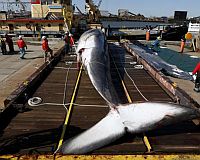 Whale sightings in and around New York harbor are getting less and less unusual. Unfortunately, the most recent sighting was of a dead fin whale caught on the bow of a container ship near Port Elizabeth. A necropsy is being performed to determine if the 60 ton whale was dead or alive when struck by the ship. Fin whales are the second largest whale in the world after the blue whale and are endangered. According to recent studies, up to 30% of all whales found dead have shown evidence of being struck by a ship.
Whale sightings in and around New York harbor are getting less and less unusual. Unfortunately, the most recent sighting was of a dead fin whale caught on the bow of a container ship near Port Elizabeth. A necropsy is being performed to determine if the 60 ton whale was dead or alive when struck by the ship. Fin whales are the second largest whale in the world after the blue whale and are endangered. According to recent studies, up to 30% of all whales found dead have shown evidence of being struck by a ship.
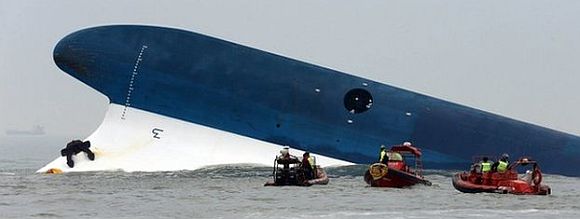
Photo: AFP
What was intended as a four-day field trip to the Korean resort island of Jeju for high school students and their teachers ended in tragedy when the ferry sank off several miles north of Byeongpung Island, on the west coast of Korea. There are reports of 4 known dead and roughly 300 people still missing.
We posted recently about a rare lunar eclipse tetrad, a sequence of four total lunar eclipses, each six months apart. The first of these total lunar eclipses was last night around 2:30 AM EST. I confess. I didn’t stay up. Fortunately others did and here is a wonderful selection of photos of the eclipse from around the world. During a total eclipse, the moon takes on a red to orange appearance due to Rayleigh scattering (which is also why the sky appears to be blue.) Because of this red tint, a moon in eclipse is often referred to as a “blood moon.”

Photo: R. Spilman
In March, we posted about “The Captain Rose House of 1773 & Kit Burns Rat Pit of 1870,” at 273 Water Street in Lower Manhattan. In addition to being the third oldest building in Manhattan, the building has a rich history as both the home of a prosperous ship captain and, one hundred years later, as Kit Burn’s notorious ‘Rat Pit.’
Just down the block at 279 Water Street is, or perhaps was, and with luck will soon be again, the oldest bar in New York, the Bridge Café. First opened in 1794 as a bar and brothel, it was frequented by sailors looking for a drink and a good time, as well as by cutthroat East River pirates. It has been the site of countless fights, robberies and several murders. The building is also said to be haunted.
The Café has been shut down since November 2012 when Hurricane Sandy’s storm surge put the neighborhood under six feet of water. The current owners have been struggling to reopen the historic establishment since then. As noted by the New York Times last October, reopening a 219-year-old building takes time. Adam Weprin, one of the owners, says “It’s gotten to the point when I tell people, ‘Two more months,’ they say, ‘That’s what you told me two months ago…’ ”
Update: We have just heard that the cafe may reopen in a matter of weeks. Great news!
In the 1850s, the establishment was called “The-Hole-in-the-Wall.” Continue reading
Maritime New Zealand (MNZ) clearly has a sense of humor. Their new advertising campaign harkens back to the glory days of 1980s cop shows to remind us that, like bulletproof vests, lifejackets don’t save people’s lives unless they’re worn.
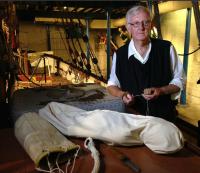
Sail maker Don Lucas at the South Australian Maritime Museum
As part of a new exhibit, Rough Medicine: Life and Death in the Age of Sail, at the South Australia Maritime Museum, sail maker Don Lucas was asked to sew a shroud for a child, actually a child-sized manikin, fortunately, to represent the preparations for a burial at sea. In a recent interview he talked about sewing the shroud:
“I did some research on how those shrouds were sewn at the time and I certainly couldn’t find anything,” Don said. Don believed the task of shroud making would lie in the hands of the ship’s sail maker, being the person most skilled at sewing, but doubted the shrouds would be made of sail canvas.
“When vessels had no other means of propulsion other than sails, one certainly wouldn’t cut a sail into little bits. From the research we have done, we believe it was most probably a bed sheet.”
A bed sheet? Really? With all due respect, I don’t think so. Continue reading
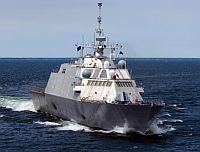 The Navy’s Littoral Combat Ship (LCS) USS Freedom, the first of her namesake class and one of two different LCS designs, was recently deployed to Singapore for ten months in order to demonstrate the capabilities of the ship described by the Navy as a “networked, agile, stealthy surface combatant capable of defeating anti-access and asymmetric threats in the littorals.” Unfortunately, USS Freedom broke down three times on its way to Singapore and then spent close to two months of the deployment tied up at the dock for repairs.
The Navy’s Littoral Combat Ship (LCS) USS Freedom, the first of her namesake class and one of two different LCS designs, was recently deployed to Singapore for ten months in order to demonstrate the capabilities of the ship described by the Navy as a “networked, agile, stealthy surface combatant capable of defeating anti-access and asymmetric threats in the littorals.” Unfortunately, USS Freedom broke down three times on its way to Singapore and then spent close to two months of the deployment tied up at the dock for repairs.
Now, reports are leaking out that Navy officers in the Pacific are, in effect, suggesting that the ship should find a smaller ocean. Bloomberg is reporting that U.S. Navy officers in the Pacific fleet say the service’s Littoral Combat Ship may lack the speed, range and electronic warfare capabilities needed to operate in Asian waters, according to a congressional audit.
 On January 9, 2013, we posted about the Seastreak Wall Street catamaran ferry, which slammed into a loading barge at Pier 11 in New York City’s East River in Lower Manhattan at 12 knots, injuring 80 of the 331 passengers and crew. The 140 feet long and 30 feet wide ferry was operating on scheduled service from Atlantic Highlands and Conners Highlands in New Jersey to Lower Manhattan. The National Transportation Saftey Board (NTSB) recently released its findings on the accident, which found that the action was caused the captain losing control of the ferry as it approached the dock, complicated by poor bridge design and lax management over-site of ferry operations.
On January 9, 2013, we posted about the Seastreak Wall Street catamaran ferry, which slammed into a loading barge at Pier 11 in New York City’s East River in Lower Manhattan at 12 knots, injuring 80 of the 331 passengers and crew. The 140 feet long and 30 feet wide ferry was operating on scheduled service from Atlantic Highlands and Conners Highlands in New Jersey to Lower Manhattan. The National Transportation Saftey Board (NTSB) recently released its findings on the accident, which found that the action was caused the captain losing control of the ferry as it approached the dock, complicated by poor bridge design and lax management over-site of ferry operations.
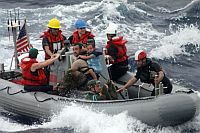
Photo:AP
I will admit to having distinctly mixed feelings related to the rescue of the Kaufman family on their yacht ‘Rebel Heart.‘ I am obviously pleased that Lyra received medical attention. I am saddened that the boat that was their home was lost. I am impressed by the skill, expertise and the resources marshaled by the California Air National Guard, the US Navy and the US Coast Guard. All these responses are fairly obvious and non-controversial. The larger question is harder to answer. KJ Dell’Antonia writes about it in the Motherlode blog in yesterday’s New York Times. The blog post is titled, “Judge the ‘Rebel Heart’ Sailboat Parents, or Envy Them?” In some respects the answer may be, both.
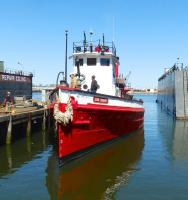
Photo: Will Van Dorp
Yesterday, we posted about the arrival of the World War II Destroyer Escort USS Slater at Caddell Dry Dock. The day before, the historic fireboat, John J. Harvey, left Caddell to return to her Hudson River dock after a month of refurbishment. The fireboat built in 1931, was drydocked, repaired, painted and had two new stacks installed. She’s looking good.
Our referrence to her as “an American treasure” is more than just metaphor. The John J. Harvey has been awarded the prestigious Federal Save America’s Treasures Grant. This grant will provide matching funds of $165,955, provided that the organization can raise an equal sum by the end of the year. So far $142,000 toward the total Save America’s Treasures matching grant has been raised. If you can help to put them over the top, please donate here.
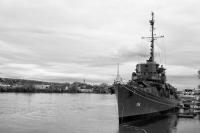
Photo: Michael Sheehan
Could the arrival of the the USS Slater, the last World War II destroyer escort still afloat in the United States, be a sign of spring in New York harbor? We can only hope, although as the sky today remains about as gray as her paint, perhaps that might be too optimistic. The old ship was towed down the Hudson River from her usual home in Albany by the tug Marigot and arrived at Caddell Dry Dock in Staten Island this morning for drydocking and repair. She was originally scheduled to go into the yard in February, but heavy ice on the Hudson kept her alongside her dock. The Slater‘s drydocking and repairs are being funded entirely by private donations.
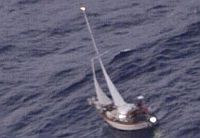
Photo: 129th Rescue Wing
Update: As reported by CBS — The Coast Guard says the baby, along with her parents and 3-year-old sister, boarded the USS Vandegrift at 8 a.m. Sunday. The baby girl was in stable condition and was heading to San Diego for medical treatment.
On Thursday, four pararescuers from the California Air National Guard 129th Rescue Wing parachuted to the 36′ sailboat, Rebel Heart, in the Pacific roughly 900 nautical miles off the coast of Cabo San Lucas, Mexico. The pararescuers helped stabilize a seriously ill one year old infant girl aboard the sailboat. USS Vandegrift, an Oliver Hazard Perry-class frigate, was dispatched from San Diego and traveled at close to 30 knots to reach the sailboat. The Vandegrift is equipped with an inflatable boat and a helicopter, but no decision has been made yet about the mode of transfer until officials can evaluate the sea conditions and other factors, said Lt. Lenaya Rotklein of the U.S. Third Fleet.
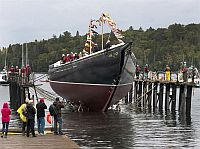
Photo: Andrew Vaughan
The new construction/restoration of the Canadian schooner Bluenose II has not gone well. Years behind schedule and millions over budget. Nova Scotia Premier Stephen McNeil is calling it a “boondoggle” and is demanding an investigation into the project. Recent lawsuits involving the schooner have cost more in legal fees alone than the cost of the original Bluenose II in 1963. The total cost of the current project is $16.7 million dollars and expected to rise still further.
Sailors watching the sky will see a total lunar eclipse on April 15th in the United States. This is the beginning of a rare tetrad, a sequence of four total lunar eclipses, each six months apart. While this will be one of nine tetrads occurring this century, in the three hundred years between 1600 and 1900, there were no lunar tetrads at all. The total eclipse of April 15, 2014, will be followed by another on Oct. 8, 2014, and another on April 4, 2015, and another on Sept. 28 2015. This video by NASA summarizes what to expect.
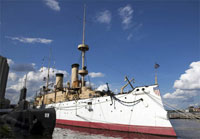 After a three year bidding process to attempt to find a new home for the historic cruiser Olympia, the Independence Seaport Museum has announced that it will keep the ship after all.
After a three year bidding process to attempt to find a new home for the historic cruiser Olympia, the Independence Seaport Museum has announced that it will keep the ship after all.
Four groups originally bid on taking over the ship but none were considered to be viable. The museum also noted that the ship was responsible for half of the museum’s 70,000 annual visitors. Museum president John Brady has announced a $20-million national fundraising campaign to support repairs to the cruiser. The museum had previously claimed that it could not afford to keep the historic ship.
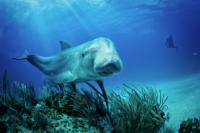
The illusive manaphin
Yesterday was April 1st, often known as April Fool’s Day. (Our post on a dramatic man overboard rescue was definitively not a spoof.) Yesterday “Visit St Pete-Clearwater” issued a press release about a recent sighting of the legendary “Manaphin” in the Gulf of Mexico, just off the coast of Pinellas County, Florida. The manaphin is a dolphin-manatee hybrid, according to the press release and an associated Manaphin web site. From the press release:
Kayaker Doug Lamal was about 20 yards from shore last Friday afternoon when the creature’s distinctive head broke the surface of the water. “I’ve seen both manatees and dolphins many times,” said the 34-year old Chicagoan. “But this was different—the thing moved like a dolphin but had the head of a manatee. It was pretty cool.”
Andrew Taylor, 46, from London, a crew member on Derry~Londonderry~Doire yacht, racing in the Clipper Round the World Race, went overboard in the Pacific at 23.43 UTC Sunday night in rough weather. He was sighted again at 00.55 UTC before being recovered at approx. 01.13 UTC (13.13 local time, 30 March). Dramatic footage of the rescue has been posted on Youtube:
Derry~Londonderry~Doire successfully recovers man overboard during Clipper Round the World
From the Clpper Round the World website:
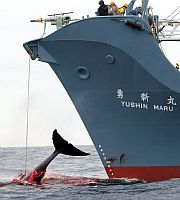 Great news. The UN’s highest court has ruled against Japanese Antarctic whaling. The Japanese have notionally supported the commercial whaling moratorium adopted in 1982 but have exploited a loophole which allows for whaling for “scientific research.” As we posted last June, the the government of Australia, supported by New Zealand, filed a suit asking the International Court to halt the Japanese whaling fleet’s annual trips to harpoon minke and fin whales. Today, the International Court of Justice at the Hague ordered a temporary halt to Japan’s Antarctic whaling program, ruling that it is not for scientific purposes as the Japanese government had claimed. As reported by CBC News:
Great news. The UN’s highest court has ruled against Japanese Antarctic whaling. The Japanese have notionally supported the commercial whaling moratorium adopted in 1982 but have exploited a loophole which allows for whaling for “scientific research.” As we posted last June, the the government of Australia, supported by New Zealand, filed a suit asking the International Court to halt the Japanese whaling fleet’s annual trips to harpoon minke and fin whales. Today, the International Court of Justice at the Hague ordered a temporary halt to Japan’s Antarctic whaling program, ruling that it is not for scientific purposes as the Japanese government had claimed. As reported by CBC News:
Reading a 12-4 decision by the court’s 16-judge panel, Presiding Judge Peter Tomka said Japan’s program fails to justify the large number of minke whales it says it needs to catch under its current Antarctic program — 850 annually — and it doesn’t catch that many anyway. It also didn’t come close to catching the 50 fin and 50 humpback whales it aimed to take… All that drew into doubt Japan’s assertion that its whaling is for scientific purposes, he said…
“The court concludes that the special permits granted by Japan for the killing, taking, and treating of whales … are not ‘for purposes of scientific research’,” Tomka said.
Japan said it would abide by the ruling but added it “regrets and is deeply disappointed by the decision”. Norway and Iceland continue to engage in commercial whaling in violation of the moratorium.

Image: Hobie.com
Hobart “Hobie” Alter died of cancer in Palm Desert, California on March 29th, 2014 at the age of 80. In 1958, he revolutionized surfboard design by developing the foam-and-fiberglass surfboard. In the 1960s, he introduced multi-hull sailing to the mass market with the Hobie Cat, eventually offering 13 different models. Over 135,000 Hobie 16 catamarans are sailing around the world. Alter also designed the Hobie 33, an ultralight displacement monohull sailboat. He also designed skateboards and the “Hobie Hawk,” a radio controlled glider. Alter sold Hobie Cat to the Coleman Company, Inc. in 1976. His sons, Hobie Jr. and Jeff, carry on the family tradition, operating Hobie Designs and overseeing the company’s licensing operations. Hobie Cats are currently manufactured in five different countries around the world.
